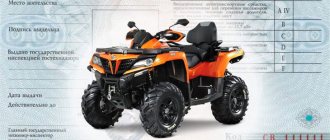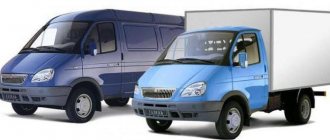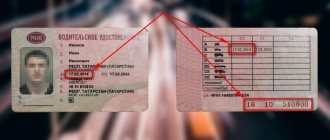What does category E mean in driving license?
Category E is an additional stamp on the license, confirming the ability to drive a vehicle in conjunction with a trailer.
However, such a license cannot be obtained without a preliminary exam for the rights of the main categories (B, C or D), since different types of cars require the use of special trailers. Holders of type A and B1 licenses, required to drive motorcycles, ATVs and tricycles, do not need an additional license. The power of the listed types of transport will not allow the use of a trailer, the carrying capacity of which will affect the quality of driving. Persons with type B license (driving a passenger car) do not always require an “E” permit. To use trailers weighing up to 0.75 tons, you do not need to undergo additional training, since a small-sized trailer does not affect the deterioration of the vehicle’s performance.
If the weight of a passenger trailer is greater than the permitted maximum (750 kg), it is necessary to undergo training to open category E in accordance with the type of vehicle being used.
Who needs category E license?
Not all trailers require category E in the rights of a person driving a tractor. Thus, without any additional permits, you can tow any trailers to vehicles of categories A and B1 - due to the limited capabilities of such a “tractor”, they all have small dimensions and weight and do not greatly affect the handling of a motorcycle, tricycle or quadricycle.
There is no need for separate licenses to tow trailers with a maximum permitted weight of up to 750 kg by vehicles of any category. The motivation is the same: such a trailer does not have a significant impact on the characteristics of the car , so no special skills are needed to drive such a “road train”. Moreover, such trailers can be quite large and spacious - for example, they can transport light motorcycles or quadricycles, small (for example, inflatable) boats, etc.
The only limitation in this case is the permitted maximum weight specified in the documents for the trailer. Therefore, before you go to study for a new category of license, carefully consider whether you really need to drive heavy trailers.
Who is who?
Category "E" is considered a more serious issue. It can be said that not everyone gets it. And there are a number of objective reasons for this.
Let's start with the fact that you have abolished the concept of category E. It does not exist independently. Three subtypes are currently used:
- BE (BE);
- DE (DE).
Russia and Ukraine use approximately the same standards, so I am sure that the situation in the neighboring country is similar.
- BE means obtaining permission to drive vehicles that belong to category B, together with a light trailer weighing more than 750 kg;
- Almost similar conditions are provided for CE. A driver with such a license can drive a vehicle from category C together with a trailer whose weight ranges from 750 to 3500 kg;
- The DE category is considered the most serious. Here the driver receives the right to drive buses with more than 8 passenger seats. Additionally, the vehicle can pull a trailer weighing 750-3500 kg.
.
I’ll say right away that buying DE rights is extremely difficult. And I don’t recommend it, because they impose serious responsibility. This is not an ordinary passenger car, but a whole road train. If you are pulling tractor trailers behind you, and there are a dozen other people sitting in the cabin, then you are responsible for them. Don’t take risks, but complete the entire training package.
Today, many driving schools offer the corresponding licensed courses in the cities of Moscow, Novosibirsk, Yekaterinburg, St. Petersburg, Kyiv, etc. In small towns with a certified educational institution there may be problems.
New subcategories
Driving instructors remind you that category E has disappeared as a separate category. But three subcategories appeared:
- BE - passenger cars with a trailer (previously they were classified as category B),
- CE - trucks with trailers,
- and the last category DE - articulated buses (relevant for large cities, where such passenger buses usually operate).
What cars can you drive with category E?
A special feature of category E is not only driving vehicles, but also driving freight trains. To drive such vehicles with trailers, you need to undergo special training related to the acquisition of complex driving skills and understanding of the rules for driving such vehicles on roads in urban conditions.
It is important to determine which trailers are considered to fall under this category. Do they include mechanisms created for transporting goods, for example, from a country house, in a passenger car, or an additional section for a bus for the purpose of transporting passengers?
The question arises, can a traffic police inspector stop such a vehicle and fine it for the absence of an indication of category E on the driver’s license? It is likely that such actions will be unlawful, since in relation to a passenger car it is necessary to obtain category BE, and in relation to a bus with a trailer, D1E. In this case, the driver cannot be fined for lack of category, since the weight of the cargo does not exceed the limit of 750 kg.
Category E does not refer to independent types, it refers to subtypes that are combined with other types of transport.
The following qualifications have been allocated:
| BE | Designed for driving category B passenger vehicles, applies to cases where the weight of the transported cargo is more than 750 kg |
| SE | Established in relation to transportation by heavy trucks with a declared weight of more than 3.5 kg with a trailer when the limits of 750 kg are exceeded |
| DE | Determined when transporting by passenger bus with more than 8 seats in the presence of a trailer weighing more than 750 kg |
Recently, other additional categories have also appeared in the legislation, including:
| C1E | Established for trucks with a trailer weighing more than 0.75 tons, but the subcategory is applied only in cases where the weight of the trailer does not exceed the weight of the truck without loading, the total amount of the train should not exceed 12 tons |
| D1E | Typical for minibuses with a number of passenger seats of no more than 16 with a trailer weighing from 0.75 tons |
Read about the penalty under compulsory motor liability insurance in the article: penalty under compulsory motor liability insurance. Find reviews of OSAGO repairs here.
Cars for professional drivers
The main difference between professionals on the road is that they are allowed to drive large and heavy vehicles with trailers or semi-trailers. To learn how to drive a truck with a trailer, you must first study for category C - driving trucks. In order to drive a car with a trailer, category E is not required.
Category E is not needed to drive a trailer weighing less than 750 kg.
According to new changes in the rules, category E is not assigned separately. Now it goes in combination with other categories:
- BE. Category BE allows you to drive a passenger car with a trailer weighing more than 750 kg.
- SE. Category CE allows you to drive a truck weighing more than 3.5 tons with a trailer or semi-trailer weighing more than 0.75 tons.
- DE. Category DE allows you to drive buses and minibuses with more than 8 passengers and a trailer weighing more than 750 kg.
- C1E. Category C1E allows you to drive a cargo vehicle with a trailer weighing more than 750 kg, but the weight of the trailer must be less than the weight of the vehicle itself.
- D1E. Category D1E allows you to drive minibuses and small buses with a maximum of 16 passengers, plus you can attach a heavy trailer.
New designations were taken from abroad. They have been practicing there for a long time.
What is Category “E” currently?
Previously, category “E” was designated by a single letter and meant a group of vehicles with a tractor that could be driven by their owner. If you pick up a new type of license today, you will no longer find this category there.
It is proposed to study and pass the exam in this category, but in addition to the following:
- B (passenger cars and small trucks weighing no more than 3500 kilograms);
- C (trucks over 3500 kilograms);
- D (buses).
Training is not provided for beginners; for this you must have at least 1 year of experience driving vehicles. As a result, the categories will look like this: BE, CE, DE. There are also C1E and D1E. We will also tell you more about them.
Category BE
Drivers whose licenses indicate this category can drive a car with a trailer. Its mass must be above 750 kilograms. The category is additional, not primary. Citizens over 18 years of age can receive it.
One limitation is introduced by driving schools; they teach a theoretical course in the subcategory and conduct practical classes only for those who:
- has no medical contraindications;
- has over 1 year of driving experience, category “B”.
We remind you that minibuses and jeeps are included in category “B”.
Category CE, C1E
CE is an additional category, and C1E is a subcategory to it. Let's figure out what these letters mean:
- CE allows you to drive a truck with a trailer weighing no more than 750 kg, but not exceeding 3500 kilograms;
- C1E is intended for trucks from 3500 to 7500 kilograms with a trailer, the minimum weight of which is 750 kilograms, and the maximum weight is not higher than the weight of the vehicle without load.
The permissible gross weight of the truck itself is 7.5 tons.
Categories DE, D1E
Let's consider two more categories that allow the driver to drive a car with a trailer. Such a vehicle is a bus.
It can also be assembled with a trailer, for which additional training is required:
- DE is a category that allows you to drive a bus carrying from 8 to 16 passengers and a trailer weighing 750 kg, with a maximum weight of 3500 kg.
- D1E is a subcategory of the previous one, for buses with a number of passengers from 8 to 16 people, as well as with a trailer weighing over 750 kilograms, provided that the entire train does not weigh more than 12 tons.
Such rights can be obtained by persons who have reached 21 years of age at the time of training.
The law dividing category “E” into additional ones came into force in 2013. At the same time, the appearance of the driver’s license also changed, new categories were added for trams, trolleybuses and even mopeds.
For those who are not familiar with the situation, we remind you that driving a moped without a license with category “M” is now prohibited!
How to get category "E"?
To open the “BE”, “CE”, “C1E” category, a citizen must meet the following requirements:
- be over 18 years of age;
- have a driving experience of at least one year.
To open categories “DE” and “D1E” you need:
- age 21;
- driving experience for more than a year.
Look at the photo for clarity:
It should be remembered that the age limit does not apply to the study of theoretical traffic rules. Books with driving principles can be bought at any bookstore, and you can start familiarizing yourself with traffic rules exam tickets from school.
When receiving category “E” you must pass a theoretical and practical exam.
Practical skills testing will take place in two stages:
- Autodrom. The driver must demonstrate the skills of coupling and disengaging with a tractor, the ability to stop, reverse and correct parallel parking for loading.
- City - test of driving in real conditions in compliance with traffic rules.
Watch the video about new exercises for categories BE, CE, DE, B1E, C1E:
If a citizen fails the exam, the authorized person must notify him of the reason for failure in writing. However, he will be able to retake it. This option is available no earlier than a week after receiving a negative result.
Package of documents
To apply for a driver’s license for category “E”, you must collect the following package of documents:
- identification document;
- fee payment receipt;
- a certificate from a medical institution confirming a medical examination;
- certificate of completion of a driving school or specialized courses;
- driver card if available;
- document confirming driving experience.
Since 2013, there is no possibility of self-training. Now, in order to pass the traffic rules exam, you must have a certificate of completion of training in a driving school with the appropriate license.
What is the price?
You can undergo training for category “E” at any driving school that is accredited in this area.
Before choosing a specialized institution, you need to pay attention to the availability of a license and the number of reviews.
Before starting your studies, it is recommended to make sure that the driving school is equipped, has specialized classes and the necessary simulators for driving training. There must be a race track on the territory that meets all regulatory requirements.
You should familiarize yourself with the production base in advance, check the qualifications of the instructors and the quality of the vehicles provided.
When choosing a driving school, it is important to pay attention not to the cost of training, but to the number of graduates who passed the exam the first time.
The price for taking courses to obtain a category “E” driver’s license varies everywhere.
Significant factors for determining the cost of training are the reputation of the school, the technical equipment of the institution, the experience of instructors and location.
As a rule, the price ranges from 15,000 to 25,000 rubles.
This video talks about obtaining the “CE” category, how much time and money it takes:
Deadlines
When attending classes 1-2 times a week, the training period is usually 1-1.5 months. In most driving schools, 16 hours are allocated for category E theory training, and 24 hours for practical classes.
How to get
The opening of an additional category is preceded by the acquisition of new theoretical and practical knowledge. Driving the vehicle itself cannot be placed on the same level as the unit attached to the rear. In addition to studying traffic rules and knowledge of responsibility for offenses, cadets receive the basics of providing first aid to a victim. They receive theoretical knowledge in classes, practical knowledge at specialized racing tracks. At the end of the course, students take exams on tickets or in the form of test tasks of the established sample.
Practical driving is practiced on an autodrome - an area intended for driving training. The various street attributes present here make it possible to bring the learning environment closer to the way of moving around a real populated area, which is what happens during further training. One of the main lessons of practical training is to develop the skill of backing a heavy trailer to the landing stage, following it in reverse. However, it will also be necessary to demonstrate knowledge of road signs in this area.
Group E allows you to drive the most complex type of transport - a car with a trailer. This requires not only good preparation, but also increased attention. A road accident involving such a unit can lead to casualties.
Therefore, before opening driver category e, a number of conditions must be met:
- Pass a special medical commission that will allow the cadet to learn to drive a combined multi-link vehicle. The commission consists of almost a dozen medical specialists, each of whom must issue a positive conclusion.
- Gain knowledge at a special education institution. This point is no less important than the previous one, because not all driving schools have the appropriate license. In addition, numerous positive reviews from former students will play a big role in properly preparing the cadet’s psychological behavior.
- Successfully complete test tasks and pass exams.
- Pay the required state fee in the amount of 2,000 rubles.
It is worth noting that the cost of a medical examination ranges from two to three and a half thousand rubles.
Cadets who receive a negative mark during the exams are given another attempt exactly 7 days later. Of course, numerous repetitions of exams are not encouraged, but if the theoretical or practical part of the science of driving has been passed, there is no need to demonstrate it again.
Do I need a category for a trailer for a car?
If the permissible maximum weight of the trailer does not exceed 750 kilograms and the total permissible maximum weight of such a combination does not exceed 3500 kilograms, then a special subcategory is not needed, in all other cases it is necessary. On a driver's license it looks like this: BE, CE and DE.
In order to open one of these categories, you must first have 1 year of driving experience. If, for example, you need a trailer for a car, then you must first drive for a year with a category B license and only then undergo training. Yes, there are special courses that teach drivers how to drive vehicles with trailers. Then you take the exam at the traffic police and after that they will open the required subcategory for you.
Conditions for obtaining category E
Vehicles with heavy trailers are characterized by large overall dimensions and weight, so training in Cat E is required. Even if it is possible to buy this category or do it through an acquaintance, it is better to unlearn it. An experienced instructor will show you the secrets of driving a long trailer, how to drive through intersections, if, for example, a 16-meter trailer or semi-trailer is attached.
Training for category "E"
Training for category “E” occurs in the same way as for other categories of driver’s licenses - in two stages. The first stage is the study of theory, during which the student masters the rules of the road, the design of a vehicle of this category, and the procedure for providing medical assistance to victims of an accident. Traffic legislation, liability for violating traffic rules and other issues are also studied.
The second stage is practical training, where the skills of driving vehicles with trailers of category “E” are acquired, both on the autodrome and on city roads.
Upon completion of training at a driving school, an internal exam is taken, and only after successfully passing it will you be allowed to take exams at the traffic police.
Which category is needed to drive heavy trailers?
“Heavy” trailers are vehicles whose maximum permissible weight exceeds 0.75 tons. Despite all their diversity three types of trailers can be distinguished , the right to drive which requires a separate category - these are trailers for cars ( BE ), trailers for trucks ( CE and C1E ) and trailers for buses ( DE and D1E ). These are three different categories of rights for which you need to pass three separate exams.
The confidence of many truckers that if they have the right to drive heavy vehicles with trailers weighing tens of tons, then they have an automatic permit for “small” passenger vehicles, unfortunately, has nothing to do with reality and is not based on knowledge legislation.
These three categories have two things in common:
- in any case, the permissible maximum weight of the trailer must not exceed the permissible maximum weight of the towing vehicle;
- To receive category E, the candidate must have had to which category E opens for at least a year.
That is, you won’t be able to pass the “trailer” exam immediately after studying for the “main” category; you need at least another year of experience.
Choosing a driving school
If you want to get category E (as well as any other), first of all pay attention to the choice of driving school. This must be a specialized educational institution with an appropriate license. Now this is a mandatory condition.
Before enrolling, be sure to make sure that there are training classes equipped with simulators where you can start learning to drive. A driving school must have its own site or racing track that meets all modern requirements.
Look at the cars you will be training on in advance and get to know the instructors. That is, the production base of the educational institution must be at its best.
When choosing a driving school, it is recommended to focus not on the cost of training, but on the percentage of graduates, the number of people who passed the traffic police exam the first time, and the reputation of the school.
How to pass for category E
Opening this category requires theoretical training, practice driving a truck with a trailer under the supervision of an instructor, and passing a final exam with the participation of traffic police officers.
What are the driver's licenses for an ATV and a snowmobile in 2021?
Education
To successfully pass the Category E license, you first need a solid theoretical basis. You can master the information either independently, by purchasing tickets and selecting the appropriate literature for the questions (both tickets and textbooks can be found electronically on the Internet), or under the guidance of an experienced specialist, or as part of a training group at a specialized driving school. Training is paid. The amount of payment depends on the driving school and region. For example, in Moscow prices fluctuate around 25 thousand rubles.
Exam preparation
The theoretical part includes acquiring knowledge about the structure of trailers of various types, their permissible load capacity, cross-country ability, the design of towing mechanisms, aggregation techniques, including coupling of vehicles with a tractor.
Separately, the issues of transferring pneumatic or hydraulic force to the brake system of the trailer, repeating the signal lights of the parent vehicle are considered: the rules for their connection, diagnosis and repair in road conditions.
A driver's license of category E also provides knowledge of the basics of first aid and the ability to provide it on the road, using available means and medications included in the standard first aid kit of a tractor-trailer.
Practical training in driving road trains is also mandatory. This takes place under the guidance and control of an experienced instructor, at a training ground specially designated for training purposes. Driving practice involves a certain number of hours and is an extremely valuable experience for a future professional.
How to restore lost rights
As part of the training, the driver not only begins to “feel the trailer”, but also learns to accurately perform lane changes and maneuvers. An experienced leader will tell you how to drive through an intersection with a multi-meter trailer-truck, how to prevent the trailer from turning out when backing up, and will explain the permissible cornering speeds for different weights, heights and couplings.
Preparation for the exam should include collecting the necessary documents that will be required to pass it. It happens that, for various reasons, the medical examination is delayed for a long time, and the candidate may simply not have time to take the exam. Read on to find out what papers you need to prepare.
As a rule, a driving school provides the opportunity to practice not on one type of trailer, for example, on a heavy and small semi-trailer, but also as part of a road train of two or even three trailers. This provides a unique experience and a great chance to become a versatile driver.
Documentation
As we said earlier, a medical certificate of health will be required. It has a validity period of three years. You will also need an extract from the work record book if the person being examined for Category E works according to the profile, or documents for ownership of a car of the required class.
Please note that 12 months of driving experience is considered sufficient at the time of passing the test. However, you can complete the training earlier than this period. At the exam, you will, of course, have to present your passport, driver's license and personal driver card.
Why do driving school students often fail the traffic police exam?
Find out the details and amount of state duty payment in advance; the receipt must be attached to the main package of documents. To confirm the successful completion of the course, upon completion, the driving school will issue an extract or other regulatory document.
Exam
The exam is conducted in the presence of a traffic police officer. For those taking the BE and CE categories, the theoretical part is not provided. Applicants for the DE category, taking into account the specifics of passenger transportation, take an exam on the ability to provide first aid to victims of an accident.
The practical part for those wishing to obtain category E includes two stages. The first is performed on a race track, where the driver demonstrates the ability to take turns, maneuver, turn around, and park on specially marked tracks. Having made sure that the driver is ready to drive, they proceed to the second phase of delivery - driving in real conditions: on city streets and expressways.
In case of failure to pass the exam the first time, the candidate receives a written document about this. You can be tested again after a week.
How do you pass exams for category E?
To obtain an o or “DE” certificate, you do not need to pass a theoretical exam. It is clear that the candidate knows the theory, since he has the right to drive a heavy truck and a bus.
A vehicle with a trailer requires high skill; it is not for nothing that such drivers are called true professionals.
The exam is taken in two stages:
- at the race track;
- on the highway or in an urban environment.
In the first case, the examiner tests the candidate's ability to drive a heavy truck. There are certain exercises that the candidate must cope with: straight reversing and placing the vehicle with its back side to the platform. Provided that the student has completed these tasks, he can proceed to the second part of the tests.
The real-time exam involves choosing a route with heavy traffic and pedestrian traffic. This will allow the examiner to determine how ready the candidate is for independent professional activity. If mistakes were made, the reason for failure will be indicated on the exam sheet. You can retake the test in a week.
A feature of category E is the high degree of responsibility that the driver must have. He will also need high skill and deep knowledge.
Passing exams at the traffic police for category “E” (“BE”, “CE”, “C1E”, “DE” and “D1E”)
Passing the traffic police exams takes place in two stages: theory and practice.
The theoretical exam is taken using exam cards, which you can familiarize yourself with, test your knowledge and take training here.
Having successfully passed the theoretical exam, you are allowed to take the practical exam at the traffic police race track (site), where you must correctly position the tailgate to the platform (Exercise No. 9) and straight-line reverse movement (Exercise No. 10).
After successfully passing the test at the race track, you must pass driving in the city.
Remember that if you fail the exam at one of the stages, you will be given a retake only after a week, not earlier. But if you failed to pass the exam in the city three times, subsequent retakes will be scheduled at intervals of a month. If in 6 months you still fail to pass the “city” test, you will have to retake the theoretical exam again.
Having successfully passed the traffic police exams, you receive the right to drive trains with category “E” trailers.
Passing exams at the traffic police and exercises at the race track
It is noteworthy that in order to open E (CE, C1E, DE, etc.), you do not need to pass the theory. You just need to go through two stages of testing your practical skills in driving a vehicle with a trailer:
- The first is testing the skills of driving a vehicle with a trailer at the traffic police track. During the test drive, the driver will need to demonstrate simple skills in driving a car with a trailer, parking skills on an overpass, and the ability to reverse;
- the second stage is testing the driver’s ability to drive a vehicle with a trailer in real city traffic conditions.
If under any circumstances you were unable to pass the traffic police driving test the first time, you will be able to retake the test for driving a car with a trailer in 7 days.
Requirements for an applicant for category E
To obtain driver categories that give the right to drive vehicles with trailers, road trains and buses, there are unique requirements:
- the category can only be obtained upon reaching 21 years of age (otherwise you will simply not be allowed to take the exams);
- driving experience with categories B, C or D is required for at least 12 months (confirmed by driving license or entries in the work book);
- To open a category, you must undergo official training at a driving school that is accredited to teach the required category;
- After completing the training, you must pass an exam at the traffic police (for BE and CE - only driving practice, for DE - theory and practice).
Important! If you took the opening exam for categories B, C or D no later than 90 days ago, part of the exam for categories BE, CE or DE does not need to be retaken (at the discretion of traffic police officers).
The practical exam consists of two parts - on a closed site/training ground and on a section of a real route with busy vehicle/pedestrian traffic. The cadets must demonstrate the correct execution of several exercises: moving forward/reverse, performing maneuvers, placing the car on the platform in reverse. If you fail the driving test, you can try again in a week.
Replacement of rights with category E
According to the current legislation, for drivers who issued an E driver's license before the end of 2000, the “Special notes” field will contain information that E is available for all existing categories. In other words, if B, C and D exist, the entry E will be added to B, C and D in the “Special Notes” field - when passing the exam, CE, BE and DE will be opened.
If you opened E in 2001 or later, you can only replace the rights to the category that was opened. In other words, if you have DE open, then to get CE and BE you will have to take the exam separately.
Cars of category "E"
A distinctive feature of this category is the right to drive a train with cargo trailers weighing over 750 kg.
Such management requires certain skills and requires training. With the onset of spring, many of our compatriots go to their countryside, attaching trailers, boats and other equipment to their cars.
Please note: there are often cases when such cars are stopped by a traffic police officer and issued a fine for the fact that the driver does not have a license. "E". The action of the employees in this case is illegal, especially if the trailer weighs less than 750 kg: cat.
“E” is not issued on its own, it is additional to the basic rights.
There are several subcategories:
- Attaching the symbol “E” to “B” gives the driver the right to drive a car with a trailer weighing no more than 7.5 ct. In this case, the driver automatically opens a subcategory if he receives a license category. "IN".
- Attaching the symbol “E” to “C” gives the subcategory “CE”, the receipt of which gives permission to drive light trucks with a trailer, dimensions up to 3.5 tons.
- The ratio “E” to “D” gives the right to drive a bus with a trailer with dimensions over 7.5 ct.
Fine for driving without a category
According to the law, fines for driving without a category are equivalent to fines for driving a car without a driver's license at all. And this:
- a fine in the amount of 5 to 15 thousand rubles;
- evacuation of the vehicle to the impound area;
- withdrawal of rights.
The exception is those cases when the driver is just undergoing training to open E, and a qualified instructor with an open license to drive vehicles is nearby.
Opening E requires considerable experience in driving and operating a car, as well as ideal knowledge of traffic rules.










